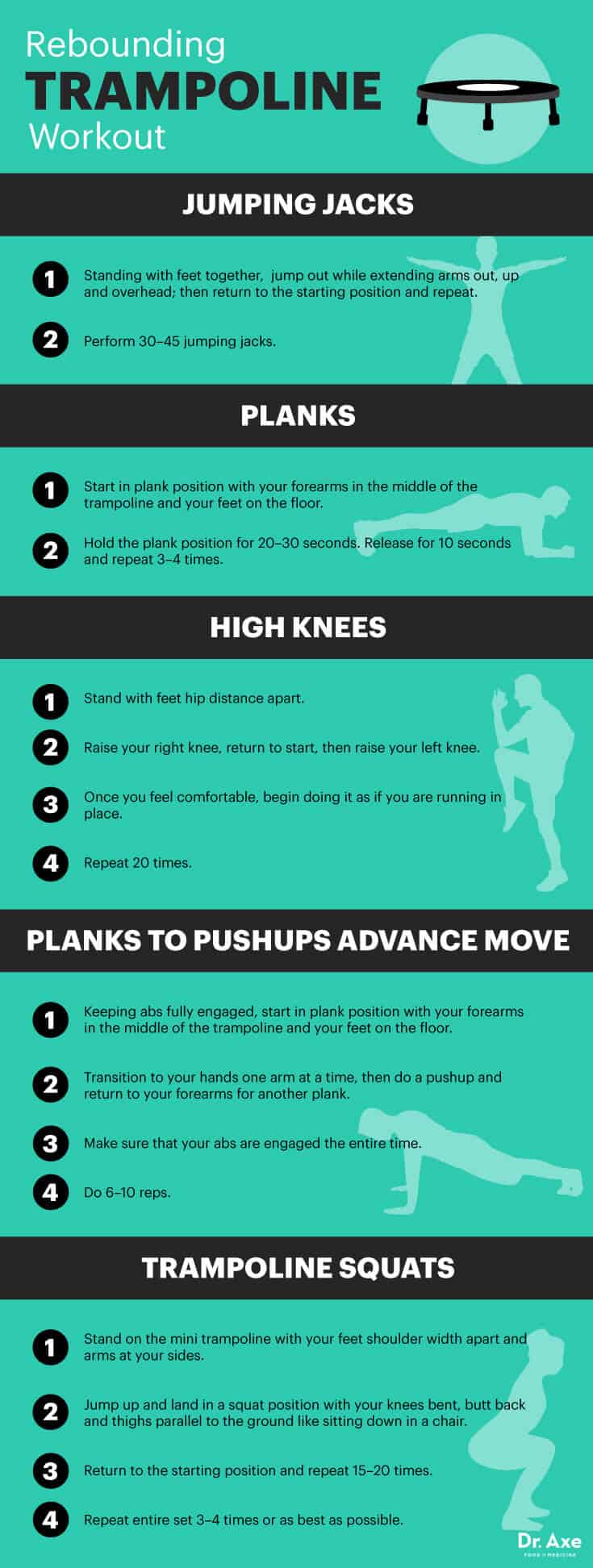The Benefits of a Trampoline Workout and Rebounding(Part Two)
How to Choose a Good Rebounder
Because many injuries can occur while on a trampoline, it’s critical that you don’t go the cheaper route because cheaper trampolines tend to break or malfunction, causing injury. They also can lack the support needed to be effective.
It’s important that your rebounder has at least 32 springs that taper at the end. This provides the proper flexibility and a more even bounce. Steel construction lasts longer, too.
Some models offer support bars, which may be useful, especially for beginners or the elderly.
Recommended trampolines:
- Bellicon
- Urban Rebounder
- Cellerciser
Trampoline Workout: How to Start Using Your Rebounder
Rebounders, or mini trampolines, can be used almost anywhere indoors or outdoors. Remember to start slow with small jumps, and make sure you get used to the equipment before you increase to bigger jumps. A trampoline workout is one idea for burst training at home. You can include some traditional exercise such as jumping jacks to get you started.
Rebounding is a great low-impact exercise that’s fun and different. In just 15—20 minutes a day, you can burn calories, gain muscle strength and enhance your balance while improving your immune system — and helping turn on the afterburn effect.
Trampoline or Rebounding Workout
Time: 20–45 minutes, depending on number of sets performed
Warmup:
Basic Trampoline Bounce
The basic bounce can tone your quads, glutes and calf muscles.
- Stand on the mini trampoline with your feet shoulder width apart.
- Relax your arms and shoulders but with a slight bend at the elbow.
- Lightly bounce up and down while keeping a slight bend in the knees. Your feet should come just a few inches off the trampoline.
- Repeat 20–30 times.
- Rest for 15 seconds and repeat 2 more times for a total of 3 rounds.
Main Set:
Jumping Jacks
A classic, this gets your heart rate up while engaging the inner and outer thighs.
- Standing with feet together, jump out while extending arms out, up and overhead; then return to the starting position and repeat.
- Perform 30–45 jumping jacks.
Planks
This plank exercise variation works your entire core.
- Start in plank position with your forearms in the middle of the trampoline and your feet on the floor (unless your trampoline is large enough for your entire body).
- Hold the plank position for 20–30 seconds. Release for 10 seconds and repeat 3–4 times.

High Knees
This is a great exercise hack that gets your heart rate moving while working your core muscles.
- Stand with feet hip distance apart.
- Raise your right knee, return to start, then raise your left knee.
- Once you feel comfortable, begin doing it as if you are running in place.
- Repeat 20 times (one on each side counts as one full rep).
Planks to Pushups Advance Move
This exercise works your entire core and provides some upper body strength in the arms and chest.
- Keeping abs fully engaged, start in plank position with your forearms in the middle of the trampoline and your feet on the floor (unless your trampoline is large enough for your entire body).
- Transition to your hands one arm at a time, then do a pushup and return to your forearms for another plank.
- Make sure that your abs are engaged the entire time.
- Do this exercise for 6–10 reps.
Trampoline Squats
Wondering how to strengthen your core? Well, this exercise requires you to engage your core muscles. It strengthens glutes and quads as well as your core if properly engaged.
- Stand on the mini trampoline with your feet shoulder width apart and arms at your sides.
- Jump up and land in a squat position with your knees bent, butt back and thighs parallel to the ground like sitting down in a chair. It may be helpful to place your arms straight out in front of you for balance.
- Return to the starting position and repeat 15–20 times. At first, you may want to take it slow. Once you have mastered the exercise, you can begin to do it a bit faster with continuous movement similar to a jump squat that you would do on the ground.
- Repeat the entire set 3–4 times or as best as possible.
Risks of a Trampoline Workout
It’s extremely important that children are always supervised when on a trampoline of any sort. The condition and quality of trampolines are critical in preventing injuries.
Because there are holes between the coils and the main surface, it’s easy for young children to get trapped. Never leave a trampoline unattended when children are present. Also, always stay in the center of the trampoline to avoid being tossed off it, which could induce injury by falling.
It’s best to consult your physician before performing any new exercise, including a trampoline exercise, especially if you have any illness or physical condition.








